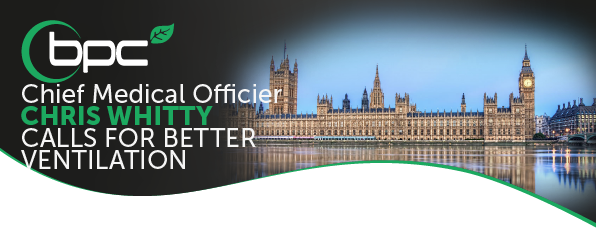Chief Medical Offer Highlights Need For Better Ventilation

UK Chief Medical Officer Demands Action on Indoor Air Pollution.
Chief medical officer report says better indoor air quality and work to introduce ‘adequate ventilation’ should be made a public health priority.
The UK’s chief medical officer has argued that decades of progress in curbing external air pollution must be matched with a similar push to tackle airborne contaminants in indoor environments.
The comments have been made in the Chief Medical Officer’s Annual Report 2022 which focuses specifically on the issue of air pollution.
Among the main conclusions of the report was that it was technically possible to effectively reduce exposure to air pollution in a range of environments. The report noted that England has already seen important reductions in outdoor levels of air pollution since the 1980s. However, it added that there was an urgent need to deliver further improvements in outdoor air pollution to tackle health threats such as heart disease, stroke, lung disease, cancer, and asthma exacerbation.
Another concern was the link between poor air quality and increased mortality rates, as well as the associated negative impacts on lung development in children.
Setting sights on better IAQ (Indoor air quality)
Professor Whitty concluded that the negative impacts of poor indoor air quality also needed to be better understood and considered in policy and health initiatives. This consideration needed to include an improved focus on how the design of buildings and ventilation systems can tackle poor IAQ.
The report said that the need to improve indoor air quality created a “major engineering challenge” that required the specification and operation of effective ventilation that could also minimise energy
use and heat loss.
It stated: “This is a priority for reducing indoor air pollution while achieving net zero carbon.”

The findings also backed a need to increase research into the most effective ways to reduce air pollution. This should include researching methods for reducing contaminants formed both inside or outside a building or environment.
Professor Whitty’s report noted that the definition of indoor air pollution can be split into two notable varieties. This included the ingress of pollutants into the indoor environment and contaminants that are emitted in a building itself.
The report added: “Inequality in indoor exposure to pollutants is linked to the quality of housing (new build or retrofitted) as well as location – whether the housing is located near busy or congested roads, or industrial sites. Indoor activities of cooking, heating and use of building materials, cleaning and personal care products can emit NO2, carbon monoxide (CO), particulate matter (PM) and volatile organic compounds (VOCs) indoors.
These indoor pollutants can also be impacted by higher occupancy levels in a building, along with a lack of adequate ventilation.
Adequate ventilation can be defined both in terms of the use of mechanical solutions, as well as passive measures such as opening windows or doors, the report stated. Both measures can conversely increase heat loss and allow outdoor pollutants into a building without additional design consideration.
Other important considerations that determine the IAQ levels of a building were measures needed to improve energy efficiency. These can include the increased use of insulation and other methods to make properties more airtight, the report added.
It stated: “[These measures] can increase indoor pollution concentrations from indoor sources if there is not also adequate ventilation for indoor pollutants to leave the building.”
Professor Whitty’s findings also noted there was a range of disparities in exposure risks to both indoor and external air pollution.
These disparities included evidence of a significant increase in the concentration of contaminants such as PM2.5, NO2 and VOCs in low-income housing following retrofit work that has increased air tightness in buildings.
The evidence used for the report was based on academic studies and research from air quality charities.
Professor’s Whitty report said: “Housing in areas of deprivation can also be affected by multiple occupants in a household, resulting in greater resuspension of particles. Security concerns can also
mean restricted window opening.”
“In homes that are not owner-occupied, residents may have less agency to improve indoor air quality, for example, through interventions to reduce dampness and mould. There is evidence that children growing up in homes with mould are between 1.5 and three times more prone to coughing and wheezing.”
Professor Whitty said in a statement that it was important to create an understanding of the significant health risks posed by poor air quality.
He said: “Everyone is affected by air pollution, and it is everyone’s problem.”
“Air pollution has improved and will continue improving provided we are active in tackling it. We can and should go further – and it is technically possible to do so.”
The government also cited the response of Dr Sarah Clarke, president of the Royal College of Physicians (RCP), to the report.
Dr Clarke said she welcomed the publication of the chief medical officer’s findings that served to highlight some of the messages of the RCP’s work to raise awareness about the impacts of poor air quality.
This included the findings of its own ‘Every Breath We Take’ report that was published in partnership with the Royal College of Paediatrics and Child Health in 2016.
She said: “We estimated then that around 40,000 deaths were attributable to outdoor air pollution, and since then a coroner found it to be a cause of death for the first time, that of 9-year-old Ella Adoo Kissi Debrah.”
“The CMO’s report is an important contribution that makes clear why we must be proactive and ambitious in our efforts to improve both outdoor and indoor air quality for everyone.”
To find out more about more about “adequate ventilation” and what would be the best practice solutions for your project or any other ventilation requirement that we can help you with, please contact us via: -
028 2827 5150
(From outside the UK - 0044 2827 5150)
8am-5pm, Mon-Thu, 8am-3.30pm, Fri
info@bpcventilation.com

